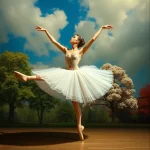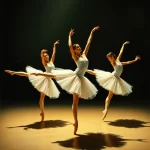Ballet: The Four Seasons (Antonio Vivaldi, 1979)

Introduction
Ballet: The Four Seasons, choreographed by John Neumeier and set to the music of Antonio Vivaldi, premiered in 1979. This ballet is a vivid interpretation of Vivaldi’s iconic violin concertos, “The Four Seasons,” which are among the most recognizable pieces of classical music. The ballet captures the essence of each season through a series of dance sequences that reflect the changing moods and atmospheres of spring, summer, autumn, and winter.
Historical Background
Creation and Development
The late 1970s was a period of significant artistic experimentation and innovation in the world of ballet. John Neumeier, an American-born choreographer who had established himself in Europe, was inspired by the timeless quality of Vivaldi’s music. The idea was to create a ballet that would not only showcase the technical prowess of the dancers but also evoke the emotional and atmospheric qualities of each season.
Neumeier’s inspiration came from various sources, including literature and folklore that depict the cyclical nature of the seasons. The collaboration between Neumeier and the musicians was crucial in bringing this vision to life. The ballet was designed to be a seamless blend of music and movement, with each element enhancing the other.
Premiere and Reception
The ballet premiered on June 15, 1979, at the Hamburg State Opera in Germany. The initial reception was overwhelmingly positive, with critics praising Neumeier’s innovative choreography and the dancers’ performances. The audience was captivated by the ballet’s ability to translate Vivaldi’s music into a visual and emotional experience.
Notable early performances included revivals in major cities across Europe and North America. Each performance brought new interpretations and nuances, further solidifying the ballet’s place in the repertoire of contemporary dance companies.
Synopsis of the Ballet
Act I Summary
The ballet opens with “Spring,” characterized by a sense of renewal and awakening. The dancers, dressed in light, flowing costumes, move gracefully to the lively and uplifting music. Key characters introduced in this act include the embodiment of Spring, who leads the ensemble in a series of joyful and exuberant dances.
Act II Summary
“Summer” follows, bringing a more intense and passionate atmosphere. The choreography becomes more dynamic and expressive, reflecting the heat and energy of the season. Major turning points include a dramatic pas de deux that symbolizes the height of summer’s intensity and the eventual transition to autumn.
Act III Summary
In “Autumn,” the mood shifts to one of reflection and preparation for the coming winter. The dancers’ movements become more grounded and introspective, mirroring the changing colors and falling leaves. The climax of this act is a powerful ensemble piece that captures the essence of harvest and thanksgiving.
Finale
The ballet concludes with “Winter,” a stark and haunting portrayal of the cold and stillness of the season. The dancers, now in darker, more subdued costumes, move with a sense of restraint and melancholy. The finale is a poignant reminder of the cyclical nature of life, ending on a note of quiet contemplation.
Musical Composition
Composer’s Role
Antonio Vivaldi, an Italian Baroque composer, is best known for his violin concertos “The Four Seasons.” These pieces are celebrated for their vivid musical imagery and technical brilliance. Vivaldi’s contribution to the ballet is foundational, as his music provides the emotional and atmospheric framework for the choreography.
Musical Themes and Motifs
Each concerto in “The Four Seasons” is associated with a specific season and contains recurring musical themes or leitmotifs that evoke the characteristics of that season. For example, “Spring” features bright, lively melodies that suggest new growth and renewal, while “Winter” includes stark, dissonant harmonies that convey cold and desolation. The music enhances the narrative and emotional depth of the ballet, making it a truly immersive experience.
Famous Recordings and Performances
There have been numerous iconic recordings of Vivaldi’s “The Four Seasons,” including those by violinists such as Itzhak Perlman and Anne-Sophie Mutter. These recordings have been used in various performances of the ballet, adding to its rich history and legacy.
Choreography and Dance
Choreographer’s Vision
John Neumeier’s vision for the ballet was to create a work that would be both visually stunning and emotionally resonant. His choreography is characterized by its fluidity and expressiveness, capturing the essence of each season through movement. Neumeier introduced several innovations, including the use of contemporary dance techniques and a more abstract, interpretive approach to storytelling.
Signature Dance Numbers
Key dances in the ballet include the pas de deux in “Summer,” which is a highlight for its intensity and emotional depth. Another notable scene is the ensemble piece in “Autumn,” which showcases the dancers’ technical skill and ability to convey complex emotions through movement.
Notable Interpretations
Over the years, different productions have brought their own interpretations to the choreography. Some have emphasized the classical elements, while others have incorporated more modern or experimental styles. These variations have kept the ballet fresh and relevant, allowing it to evolve with the times.
Characters and Roles
Main Characters
The main characters in the ballet are the embodiments of the four seasons: Spring, Summer, Autumn, and Winter. Each character has a distinct personality and role within the narrative. Spring is joyful and exuberant, Summer is intense and passionate, Autumn is reflective and grounded, and Winter is stark and contemplative.
Supporting Characters
Supporting characters include various nature spirits and elements that interact with the main characters. These roles add depth and complexity to the story, enriching the overall experience.
Famous Dancers
Notable dancers who have portrayed these roles include Marcia Haydée as Spring, Ivan Liska as Summer, and Lloyd Riggins as Winter. Their performances have been celebrated for their technical brilliance and emotional depth.
Cultural and Artistic Impact
Influence on Ballet and Dance
The ballet has had a significant influence on other works and choreographers. Its innovative use of Vivaldi’s music and contemporary dance techniques has inspired many subsequent productions. It has also played a role in the development of ballet as an art form, pushing the boundaries of what is possible in dance.
Cultural Significance
The ballet’s place in popular culture is evident in its numerous adaptations in film, theater, and other media. It has been referenced in literature and has inspired various artistic works, making it a cultural touchstone.
Legacy and Revivals
Major revivals and reinterpretations of the ballet continue to be performed today. These productions keep the ballet alive and relevant, ensuring that it remains a beloved part of the dance repertoire.
Iconic Productions
Historic Productions
Historic productions of the ballet include its original 1979 premiere at the Hamburg State Opera and subsequent performances in major cities around the world. Key figures involved in these productions include John Neumeier as choreographer and various renowned dancers and musicians.
Contemporary Productions
Recent productions have brought new interpretations and innovations to the ballet. These contemporary performances often incorporate modern dance techniques and updated production designs, offering fresh perspectives on the classic work.
Production Design
The set, costume, and lighting design in various productions have played a crucial role in bringing the ballet to life. From the light, airy costumes of Spring to the dark, subdued attire of Winter, each element is carefully crafted to enhance the overall experience.
Critical Reception and Reviews
Initial Critical Response
The initial critical response to the ballet was overwhelmingly positive. Critics praised Neumeier’s innovative choreography and the dancers’ performances, noting the ballet’s ability to translate Vivaldi’s music into a visual and emotional experience.
Modern Reviews
Contemporary critics and audiences continue to appreciate the ballet for its timeless quality and emotional depth. The ballet remains relevant and popular today, with many praising its ability to evoke the essence of each season through dance and music.
Fun Facts and Trivia
Behind-the-Scenes Stories
One interesting anecdote from the production involves a last-minute change in the choreography for the “Summer” pas de deux. Neumeier decided to make the change just hours before the premiere, resulting in a more dynamic and intense performance.
Notable Performers
Famous dancers associated with the ballet include Marcia Haydée, Ivan Liska, and Lloyd Riggins. Their performances have been celebrated for their technical brilliance and emotional depth.
Trivia
Did you know that Vivaldi’s “The Four Seasons” was originally published with accompanying sonnets that describe the scenes depicted in the music? These sonnets provide additional context and insight into the ballet’s narrative.
Conclusion
Summary of the Ballet’s Importance
Ballet: The Four Seasons is a significant work in the world of dance for its innovative choreography, emotional depth, and seamless integration of music and movement. It has influenced numerous other works and continues to be a beloved part of the dance repertoire.
Final Thoughts
The ballet remains a timeless and evocative work that captures the essence of each season through dance and music. Whether you are a seasoned ballet enthusiast or a newcomer to the art form, Ballet: The Four Seasons offers a rich and rewarding experience that is not to be missed.
FAQ
What is the central theme of this ballet?
The central theme of the ballet is the cyclical nature of the seasons and the emotions and atmospheres associated with each one.
Who are the main characters in this ballet?
The main characters are the embodiments of the four seasons: Spring, Summer, Autumn, and Winter.
What is the most famous dance number in this ballet?
The most famous dance number is the pas de deux in “Summer,” known for its intensity and emotional depth.
How long does a typical performance of this ballet last?
A typical performance of the ballet lasts approximately 90 minutes, including intermissions.
Are there any modern adaptations of this ballet?
Yes, there have been numerous modern adaptations that incorporate contemporary dance techniques and updated production designs.
Why is this ballet considered important in the history of dance?
The ballet is considered important for its innovative choreography, emotional depth, and seamless integration of music and movement. It has influenced numerous other works and continues to be a beloved part of the dance repertoire.





